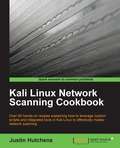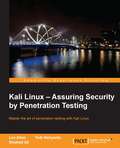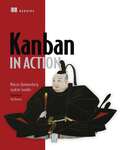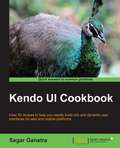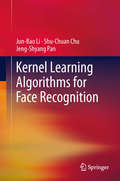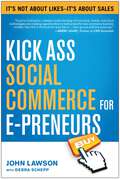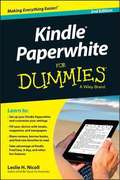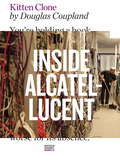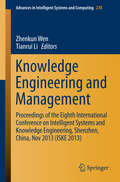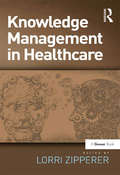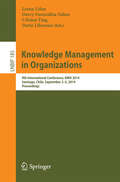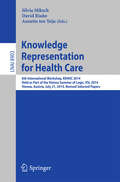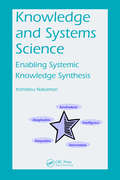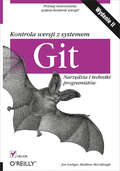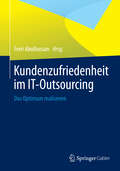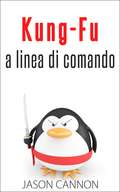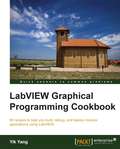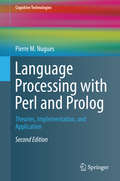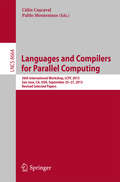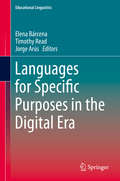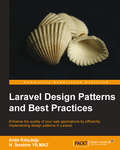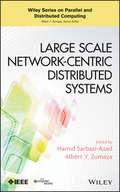- Table View
- List View
Kali Linux Network Scanning Cookbook
by Justin Hutchens"Kali Linux Network Scanning Cookbook" is intended for information security professionals and casual security enthusiasts alike. It will provide the foundational principles for the novice reader but will also introduce scripting techniques and in-depth analysis for the more advanced audience. Whether you are brand new to Kali Linux or a seasoned veteran, this book will aid in both understanding and ultimately mastering many of the most powerful and useful scanning techniques in the industry. It is assumed that the reader has some basic security testing experience.
Kali Linux – Assuring Security by Penetration Testing
by Tedi Heriyanto Shakeel Ali Lee AllenWritten as an interactive tutorial, this book covers the core of Kali Linux with real-world examples and step-by-step instructions to provide professional guidelines and recommendations for you. The book is designed in a simple and intuitive manner that allows you to explore the whole Kali Linux testing process or study parts of it individually. If you are an IT security professional who has a basic knowledge of Unix/Linux operating systems, including an awareness of information security factors, and want to use Kali Linux for penetration testing, then this book is for you.
Kanban in Action
by Joakim Sunden Marcus HammarbergSummaryKanban in Action is a down-to-earth, no-frills, get-to-know-the-ropes introduction to kanban. It's based on the real-world experience and observations from two kanban coaches who have introduced this process to dozens of teams. You'll learn the principles of why kanban works, as well as nitty-gritty details like how to use different color stickies on a kanban board to help you organize and track your work items.About the BookToo much work and too little time? If this is daily life for your team, you need kanban, a lean knowledge-management method designed to involve all team members in continuous improvement of your process.Kanban in Action is a practical introduction to kanban. Written by two kanban coaches who have taught the method to dozens of teams, the book covers techniques for planning and forecasting, establishing meaningful metrics, visualizing queues and bottlenecks, and constructing and using a kanban board.Written for all members of the development team, including leaders, coders, and business stakeholders. No experience with kanban is required.Purchase of the print book includes a free eBook in PDF, Kindle, and ePub formats from Manning Publications.What's InsideHow to focus on work in process and finish fasterExamples of successful implementationsHow team members can make informed decisionsAbout the AuthorsMarcus Hammarberg is a kanban coach and software developer with experience in BDD, TDD, Specification by Example, Scrum, and XP. Joakim Sundén is an agile coach at Spotify who cofounded the first kanban user groups in Europe.Table of ContentsPART 1 LEARNING KANBANTeam Kanbaneros gets startedPART 2 UNDERSTANDING KANBANKanban principlesVisualizing your work Work itemsWork in processLimiting work in processManaging flowPART 3 ADVANCED KANBANClasses of servicePlanning and estimatingProcess improvement Using metrics to guide improvementsKanban pitfallsTeaching kanban through games
Kendo UI Cookbook
by Sagar GanatraThis book is an easy-to-follow guide full of hands-on examples that allows you to learn and build visually compelling web applications using the Kendo UI library. This book will do wonders for web developers having knowledge of HTML and Javascript and want to polish their skills in building applications using the Kendo UI library.
Kernel Learning Algorithms for Face Recognition
by Jeng-Shyang Pan Jun-Bao Li Shu-Chuan ChuKernel Learning Algorithms for Face Recognition covers the framework of kernel based face recognition. This book discusses the advanced kernel learning algorithms and its application on face recognition. This book also focuses on the theoretical deviation, the system framework and experiments involving kernel based face recognition. Included within are algorithms of kernel based face recognition, and also the feasibility of the kernel based face recognition method. This book provides researchers in pattern recognition and machine learning area with advanced face recognition methods and its newest applications.
Kernel Methods and Machine Learning
by S. Y. KungOffering a fundamental basis in kernel-based learning theory, this book covers both statistical and algebraic principles. It provides over 30 major theorems for kernel-based supervised and unsupervised learning models. The first of the theorems establishes a condition, arguably necessary and sufficient, for the kernelization of learning models. In addition, several other theorems are devoted to proving mathematical equivalence between seemingly unrelated models. With over 25 closed-form and iterative algorithms, the book provides a step-by-step guide to algorithmic procedures and analysing which factors to consider in tackling a given problem, enabling readers to improve specifically designed learning algorithms, build models for new applications and develop efficient techniques suitable for green machine learning technologies. Numerous real-world examples and over 200 problems, several of which are Matlab-based simulation exercises, make this an essential resource for graduate students and professionals in computer science, electrical and biomedical engineering. Solutions to problems are provided online for instructors.
Kick Ass Social Commerce for E-preneurs: It's Not About Likes--It's About Sales
by John Lawson Debra ScheppIt's not about Likes—it's about sales. You're not alone. Almost all businesses are marketing online these days—everyone tweets, posts to social networks, and blogs. What you're doing now is not enough to make your business stand out. Forget what all the self-proclaimed &“social media gurus" are telling you. Being active on social media and being successful in social commerce are not the same things. Simply getting a bunch of followers or Likes doesn't cut it anymore. In Kick Ass Social Commerce for E-Preneurs, award-winning digital media strategist John Lawson gives you a straight-shooting, no-holds-barred guide to social commerce. In other words, he shows you how to make money online using social media. One of the most-respected and listened-to voices in the worlds of e-commerce and small business, Lawson stands alone because he can actually back up his words. Lawson is a multi-platform PowerSeller, whose internet businesses have rung up millions of dollars in sales. In Kick Ass Social Commerce for E-Preneurs, Lawson and bestselling e-commerce author Debra Schepp take you step-by-step through: Creating a business plan using a simple, effective template, a proven blueprint for all stages of marketing—from start-up to empire Employing the best social commerce strategy for Facebook, Twitter, LinkedIn, YouTube, and the hottest new social media sites Building a thriving e-commerce business and keeping it vibrant and growing What are you waiting for? Read this book and start kicking social commerce ass.
Kindle Paperwhite For Dummies
by Leslie H. NicollGet the inside story on the all-new Kindle Paperwhite with help from For DummiesIt reads like a book, but it's so much more. The Kindle Paperwhite is the ultimate e-reader, and this updated edition of Kindle Paperwhite For Dummies is your ultimate guide to getting more from this one-of-a-kind device. You'll learn to set up your Paperwhite, adjust the font to your liking, find your favorite books, magazines, and newspapers, and sync your Kindle content across devices before moving on to new Paperwhite features like Kindle FreeTime, Goodreads integration, Vocabulary Builder, In-line Footnotes, and Page Flip.Shows you how to navigate the touchscreen, work with the Paperwhite icons, connect via Wi-Fi, customize text size, and get personal recommendationsExplains how to purchase and download books, try out sample chapters before you buy, subscribe to magazines and newspapers, and find free books or books that can be borrowed from the Kindle Lending LibraryTells you how to take advantage of cool Kindle Paperwhite features like encouraging reading with Kindle FreeTime, learning new words with Vocabulary Builder, translating passages into other languages, sharing your recommendations with other readers via Goodreads, and delving deeper into a book's characters and content with X-RayIt's prime time you got to know the powerful, popular Paperwhite with help from Kindle Paperwhite For Dummies, 2nd Edition.
Kitten Clone
by Douglas CouplandDouglas Coupland, one of the world's biggest cultural brains, takes an inside look at the global company that keeps us connected, and wonders what all that connectivity is doing to our brains and our sense of ourselves as humans. The incomparable Douglas Coupland reports from inside the corporate offices and science labs of Alcatel-Lucent, a globally influential business whose work is largely unknown to consumers. "Were it to vanish tomorrow," he writes, "our modern world would grind to a halt. The Internet would implode--your Internet would implode." Although his examination of the company is playful and fascinating in its own right, Coupland's account is driven by his thoughtful reflections on the larger cultural and sociological significance of the transformative information technology Alcatel works on: fiber wire, microprocessors, the Internet and mobile technologies. And by a larger meditation about what the Internet is doing to us as it relentlessly colonizes the planet, and our brains. Like Coupland's best work, Kitten Clone is a wildly entertaining yet penetrating encounter with the technological and cultural forces that surround us. And also a surprising and unique exploration of a possible future.From the Trade Paperback edition.
Knowledge Engineering and Management
by Tianrui Li Zhenkun Wen"Knowledge Engineering and Management" presents selected papers from the 2013 International Conference on Intelligent Systems and Knowledge Engineering (ISKE2013). The aim of this conference is to bring together experts from different expertise areas to discuss the state-of-the-art in Intelligent Systems and Knowledge Engineering, and to present new research results and perspectives on future development. The topics in this volume include, but not limited to: Knowledge Representation and Modeling, Knowledge Maintenance, Knowledge Elicitation, Knowledge-Based Systems (KBS), Content Management and Knowledge Management Systems, Ontology Engineering, Data Mining and Knowledge Discovery, Knowledge Acquisition, etc. The proceedings are benefit for both researchers and practitioners who want to utilize knowledge engineering methods in their specific research fields. Dr. Zhenkun Wen is a Professor at the College of Computer and Software Engineering, Shenzhen University, China. Dr. Tianrui Li is a Professor at the School of Information Science and Technology, Southwest Jiaotong University, Xi'an, China.
Knowledge Management in Healthcare
by Lorri ZippererKnowledge management goes beyond data and information capture in computerized health records and ordering systems; it seeks to leverage the experiences of all who interact in healthcare to enhance care delivery, teamwork, and organizational learning. Knowledge management - if envisioned thoughtfully - takes a systemic approach to implementation that includes the embodiment of a learning culture. Knowledge is then used to support that culture and the knowledge workers within it to encourage them to share what they know, thusly enabling their peers, their organizations and ultimately their patients to benefit from their experience to proactively dismantle hierarchy and encourage sharing about what works, and what doesn’t to focus efforts on improvement. Knowledge Management in Healthcare draws on relevant business, clinical and health administration literature plus the analysis of discussions with a variety of clinical, administrative, leadership, patient and information experts. The result is a book that will inform thinking on knowledge access needs to mitigate potential failures, design lasting improvements and support the sharing of what is known to enable work towards attaining high reliability. It can be used as a general tool for leaders and individuals wishing to devise and implement a knowledge-sharing culture in their institution, design innovative activities supporting transparency and communication to strengthen existing programs intended to enhance knowledge sharing behaviours and contribute to high quality, safe care.
Knowledge Management in Organizations
by Lorna Uden I-Hsien Ting Darcy Fuenzaliza Oshee Dario LiberonaThis book contains the refereed proceedings of the 9th International Conference on Knowledge Management in Organizations (KMO) held in Santiago, Chile, during September 2014. The theme of the conference is "Knowledge Management to Improve Innovation and Competitiveness through Big Data. " The KMO conference brings together researchers and developers from industry and academia to discuss and research how knowledge management using big data can improve innovation and competitiveness. The 39 contributions accepted for KMO 2014 were selected from 89 submissions and are organized in sections on: big data and knowledge management, knowledge management practice and case studies, information technology and knowledge management, knowledge management and social networks, knowledge management in organizations, and knowledge transfer, sharing and creation.
Knowledge Representation for Health Care
by David Riaño Silvia Miksch Annette Ten TeijeThis book constitutes the refereed proceedings of the 6th International Workshop on Knowledge Representation for Health Care, KR4HC 2014, held as part of the Vienna Summer of Logic, VSL 2014, in Vienna, Austria, in July 2014. The workshop aimed at attracting the interest of novel research and advances contributing in the definition, representation and exploitation of health care knowledge in medical informatics. The 12 revised full research papers and 4 short papers presented in this book were carefully reviewed and selected from 26 submissions.
Knowledge Representation, Reasoning, and the Design of Intelligent Agents
by Dr Michael Gelfond Yulia KahlKnowledge representation and reasoning is the foundation of artificial intelligence, declarative programming, and the design of knowledge-intensive software systems capable of performing intelligent tasks. Using logical and probabilistic formalisms based on answer set programming (ASP) and action languages, this book shows how knowledge-intensive systems can be given knowledge about the world and how it can be used to solve non-trivial computational problems. The authors maintain a balance between mathematical analysis and practical design of intelligent agents. All the concepts, such as answering queries, planning, diagnostics, and probabilistic reasoning, are illustrated by programs of ASP. The text can be used for AI-related undergraduate and graduate classes and by researchers who would like to learn more about ASP and knowledge representation.
Knowledge and Systems Science: Enabling Systemic Knowledge Synthesis
by Yoshiteru NakamoriIntegrating ideas from the fields of systems science and knowledge science, Knowledge and Systems Science: Enabling Systemic Knowledge Synthesis shows how to create and justify various pieces of knowledge systemically. Written by one of the foremost experts in this area, the book presents approaches for the systemic integration of knowledge, which
Kontrola wersji z systemem Git. Narz?dzia i techniki programistów. Wydanie II
by Jon Loeliger Matthew McCulloughSystemy kontroli wersji przechodz? ci?g?? ewolucj?. Jeszcze niedawno popularny by? system CVS, który zosta? wyparty przez SVN. Ostatnie lata to inwazja rozproszonych systemów kontroli wersji z Gitem na czele. Git pozwala ka?demu programi?cie na posiadanie prywatnego repozytorium i korzystanie z jego dobrodziejstw bez wp?ywu na inne repozytoria. Jeste? ciekaw, jakie jeszcze zalety ma Git?Je?eli tak, trafi?e? na idealn? ksi??k?, dzi?ki której b?yskawicznie wkroczysz w ?wiat Gita. Na pocz?tek krok po kroku przejdziesz przez proces instalacji, a nast?pnie dostosujesz ?rodowisko do swoich potrzeb. W kolejnych rozdzia?ach poznasz dost?pne polecenia oraz nauczysz si? zarz?dza? plikami. Ponadto przekonasz si?, jak ?atwo mo?na stworzy? odga??zienia kodu oraz przegl?da? ró?nice pomi?dzy wersjami pliku. Git posiada zaawansowane narz?dzia do ??czenia kodu - b?dziesz móg? je dog??bnie pozna?. Na koniec przeczytasz o zaawansowanych mo?liwo?ciach systemu Git, takich jak wspó?praca z SVN. Ta ksi??ka jest doskona?ym podr?cznikiem dla ka?dego pocz?tkuj?cego u?ytkownika systemu Git, zaawansowani równie? znajd? tu sporo przydatnych informacji. Wykorzystaj potencja? Gita!Dzi?ki tej ksi??ce: odkryjesz rozproszone systemy kontroli wersji poznasz ich zalety zainstalujesz i skonfigurujesz system Git poznasz system kontroli wersji GitWykorzystaj potencja? systemu kontroli wersji Git!
Kundenzufriedenheit im IT-Outsourcing: Das Optimum realisieren
by Ferri AbolhassanAnknüpfend an "Der Weg zur modernen IT-Fabrik" zeigt das Fachbuch anhand von Best-Practice-Beispielen und Erfahrungswerten, welche Maßnahmen ein Unternehmen heute ergreifen kann, um Kunden langfristig zufriedenzustellen und den Qualitätsanspruch an Lösungen - von der Produktion zur Implementierung und darüber hinaus - zu sichern.
Kung-Fu A Linea Di Comando
by Eugenia Franzoni Jason CannonDiventate Ninja di Linux con "Kung-Fu a linea di comando"!Pensate di dovervi chiudere in cantina a leggere criptiche pagine man per mesi per poter diventare un ninja della linea di comando?In realtà, se qualcuno condivide con voi i trucchi e suggerimenti più potenti, vi potete risparmiare molto tempo e frustrazione. Cosa succederebbe se poteste stare a guardare un amico che per caso è un guru della linea di comando? E se vi mostrasse non solo i comandi che usa, ma anche perché e come funzionano esattamente? E se quell'amico scrivesse tutto in modo che possiate riguardarlo quando volete?Beh, un amico ha fatto proprio questo: questo libro è una raccolta di dozzine di suggerimenti e oltre 100 esempi di applicazione reale. Non troverete esempi teorici, ma solo soluzioni di problemi reali per arrivare a degli obiettivi validi.I contenuti sono anche facili da trovare; ogni capitolo copre un argomento specifico, e raggruppa suggerimenti ed esempi correlati; ad esempio, se dovete estrarre del testo da un file potete leggere il capitolo "Elaborazione e manipolazione dei testi".Inoltre, alla fine del libro c'è un indice completo; se volete trovare tutti gli esempi in cui viene usato uno specifico comando, anche se non è quello principale, usate l'indice, in cui c'è un collegamento a ogni posto del libro in cui il comando appare.Ecco solo alcune delle cose che imparerete leggendo "Kung-Fu a linea di comando":Come ripetere velocemente i comandi nella storia della shellScorciatoie per recuperare parole specifiche dalla storia della shell, da usare nel comando correnteCome salvare una copia della sessione a linea di comando da usare successivamenteCome togliere le linee vuote e i commenti dai fileCome controllare il testo a colori quando si usano le pipe e i paginatoriModi per trasformare il testo: dal maiuscolo e minuscolo alla sostituzione di caratteri, e molto altroCome estrarre specifici blocchi di testo dai file o dai
LabVIEW Graphical Programming Cookbook
by Yik YangThis practical and realistic guide will give you independent recipes, concentrating on advanced level concepts so that you can make your applications. If you are a developer, scientist, or engineer who uses LabVIEW to test, develop and manage advanced level applications, then this is the book for you. Prerequisites include proficiency in C or C++, and workable knowledge of LabVIEW.
Language Processing with Perl and Prolog
by Pierre M. NuguesThe areas of natural language processing and computational linguistics have continued to grow in recent years, driven by the demand to automatically process text and spoken data. With the processing power and techniques now available, research is scaling up from lab prototypes to real-world, proven applications. This book teaches the principles of natural language processing, first covering practical linguistics issues such as encoding and annotation schemes, defining words, tokens and parts of speech and morphology, as well as key concepts in machine learning, such as entropy, regression and classification, which are used throughout the book. It then details the language-processing functions involved, including part-of-speech tagging using rules and stochastic techniques, using Prolog to write phase-structure grammars, syntactic formalisms and parsing techniques, semantics, predicate logic and lexical semantics and analysis of discourse and applications in dialogue systems. A key feature of the book is the author's hands-on approach throughout, with sample code in Prolog and Perl, extensive exercises, and a detailed introduction to Prolog. The reader is supported with a companion website that contains teaching slides, programs and additional material. The second edition is a complete revision of the techniques exposed in the book to reflect advances in the field the author redesigned or updated all the chapters, added two new ones and considerably expanded the sections on machine-learning techniques.
Language, Space and Mind
by Paul ChiltonThe idea that spatial cognition provides the foundation of linguistic meanings, even highly abstract meanings, has been put forward by a number of linguists in recent years. This book takes this proposal into new dimensions and develops a theoretical framework based on simple geometric principles. All speakers are conceptualisers who have a point of view both in a literal and in an abstract sense, choosing their perspective in space, time and the real world. The book examines the conceptualising properties of verbs, including tense, aspect, modality and transitivity, as well as the conceptual workings of grammatical constructions associated with counterfactuality, other minds and the expression of moral force. It makes links to the cognitive sciences throughout and concludes with a discussion of the relationship between language, brain and mind.
Languages and Compilers for Parallel Computing
by Călin Caşcaval Pablo MontesinosThis book constitutes the thoroughly refereed post-conference proceedings of the 26th International Workshop on Languages and Compilers for Parallel Computing, LCPC 2013, held in Tokyo, Japan, in September 2012. The 20 revised full papers and two keynote papers presented were carefully reviewed and selected from 44 submissions. The focus of the papers is on following topics: parallel programming models, compiler analysis techniques, parallel data structures and parallel execution models, to GPGPU and other heterogeneous execution models, code generation for power efficiency on mobile platforms, and debugging and fault tolerance for parallel systems.
Languages for Specific Purposes in the Digital Era
by Elena Bárcena Timothy Read Jorge ArúsExplores the direct relation of modern CALL (Computer-Assisted Language Learning) to aspects of natural language processing for theoretical and practical applications, and worldwide demand for formal language education and training that focuses on restricted or specialized professional domains. Unique in its broad-based, state-of-the-art, coverage of current knowledge and research in the interrelated fields of computer-based learning and teaching and processing of specialized linguistic domains. The articles in this book offer insights on or analyses of the current state and future directions of many recent key concepts regarding the application of computers to natural languages, such as: authenticity, personalization, normalization, evaluation. Other articles present fundamental research on major techniques, strategies and methodologies that are currently the focus of international language research projects, both of a theoretical and an applied nature.
Laravel Design Patterns and Best Practices
by Arda Kilicdagi H. Ibrahim YilmazThis book is a practical guide packed with clear examples that will help you get to grips with the best practices in Laravel design patterns to create advanced web applications. This book is intended for web application developers working with Laravel who want to increase the efficiency of their web applications. It assumes that you have some experience with the Laravel PHP framework and are familiar with coding OOP methods.
Large Scale Network-Centric Distributed Systems
by Albert Y. Zomaya Hamid Sarbazi-AzadA highly accessible reference offering a broad range of topics and insights on large scale network-centric distributed systemsEvolving from the fields of high-performance computing and networking, large scale network-centric distributed systems continues to grow as one of the most important topics in computing and communication and many interdisciplinary areas. Dealing with both wired and wireless networks, this book focuses on the design and performance issues of such systems.Large Scale Network-Centric Distributed Systems provides in-depth coverage ranging from ground-level hardware issues (such as buffer organization, router delay, and flow control) to the high-level issues immediately concerning application or system users (including parallel programming, middleware, and OS support for such computing systems). Arranged in five parts, it explains and analyzes complex topics to an unprecedented degree:Part 1: Multicore and Many-Core (Mc) Systems-on-ChipPart 2: Pervasive/Ubiquitous Computing and Peer-to-Peer SystemsPart 3: Wireless/Mobile NetworksPart 4: Grid and Cloud ComputingPart 5: Other Topics Related to Network-Centric Computing and Its ApplicationsLarge Scale Network-Centric Distributed Systems is an incredibly useful resource for practitioners, postgraduate students, postdocs, and researchers.
